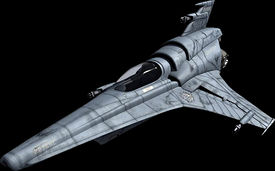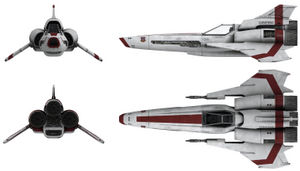Viper (TRS): Difference between revisions
More actions
Changed layout, typos and mis-use of apostophy |
Spencerian (talk | contribs) |
||
| Line 97: | Line 97: | ||
== Sources == | == Sources == | ||
#{{note|dimensions}}Dimensions provided by [http://www.leestringer.com/ Lee Stringer], one of the VFX Animators of the | #{{note|dimensions}}Dimensions provided by [http://www.leestringer.com/ Lee Stringer], one of the VFX Animators of the miniseries. These are for the CGI models, which are based on but not identical to the fullsize props. Source: [http://www.starshipbuilder.com/ubb/Forum4/HTML/000012.html Starshipbuilder.com forums] | ||
#{{note|companion}}{{note_label|companion|2|a}}Armaments listings and | #{{note|companion}}{{note_label|companion|2|a}}Armaments listings and ejector seat details from David Bassom's <i>[[The Official Companion|Battlestar Galactica: The Official Companion]]</i>. | ||
[[Category:A to Z]] | [[Category:A to Z]] | ||
Revision as of 18:22, 24 April 2006
- This article discusses the two Viper-class fighters seen in the Re-imagined Series. For information on the Viper used in the Original Series and in Galactica 1980, see Viper (TOS).
| Viper Mk. II | |||
|---|---|---|---|

| |||
| [show/hide spoilers] Spoilers hidden in infobox by default only. | |||
| Race: | Colonial | ||
| Type: | Military | ||
| FTL: | No | ||
| Propulsion: | |||
| Crew: | 1 pilot | ||
| Capacity: | |||
| CO: | |||
| XO: | |||
| Role: | Space superiority fighter | ||
| Weapons: | 2 Kinetic Energy Weapons, missiles | ||
| Armaments: | {{{arm}}} | ||
| Defenses: | {{{def}}} | ||
| Aircraft: | {{{aircraft}}} | ||
| Aviation facilities: | {{{facilities}}} | ||
| Emblem: | [[File:{{{patch}}}|175px|Ship's patch]] | ||
| Other Images: | Gallery | ||
| Length: | {{{length}}} | ||
| Width: | {{{width}}} | ||
| Height: | {{{height}}} | ||
| Weight: | {{{weight}}} | ||
| Wingspan: | {{{wingspan}}} | ||
| Other: | {{{otherdi}}} | ||
| Cost: | {{{construction}}} | ||
| Construction Time: | {{{construction}}} | ||
| Hull Size: | {{{hull size}}} | ||
| Hull: | {{{hull}}} | ||
| FTL Cooldown: | {{{ftl cooldown}}} turns | ||
| Speed: | {{{speed}}} m/s | ||
| Turn Rate: | {{{turn rate}}}°/turn | ||
| Armor Total: | {{{armor total}}} | ||
| Armor Left: | {{{armor left}}} | ||
| Armor Right: | {{{armor right}}} | ||
| Armor Front: | {{{armor front}}} | ||
| Armor Rear: | {{{armor rear}}} | ||
| Armor Top: | {{{armor top}}} | ||
| Armor Bottom: | {{{armor bottom}}} | ||
| DRADIS Range: | {{{dradis range}}} m | ||
| Processing Power: | {{{processing power}}} | ||
| Munition Slots: | {{{munitions}}} | ||
| Munition Cooldown Period: | {{{munition cooldown}}} turns | ||
| Squadron Slots: | {{{squadrons}}} | ||
| Squadron Size: | {{{squadron size}}} | ||
| Special Abilities: | {{{special abilities}}} | ||
| Additional Information | |||
The Viper is the Colonial Fleet's primary space superiority fighter / attack craft. Capable of atmospheric flight, the Viper is a single-seat craft mounting two kinetic energy weapons (KEWs), as well as having hardpoints beneath the wings for mounting missiles, munitions pods and other ordnance (The Hand of God).
The Viper was originally introduced into Colonial service shortly before the outbreak of the Cylon War. However, it was the Mark II variant, designed specifically for use with the new Colonial battlestars that is best remembered.
The Mark II served with distinction throughout the Cylon War, proving a capable fighting vehicle that won renown across the Twelve Colonies and is regarded as one of the reasons the Colonials did not suffer defeat at the hands of the Cylons.
The Mark II remained in service after the end of the war, but was subsequently superseded by newer models. At the time of the renewed Cylon attack on the Twelve Colonies, the Mark VII was the front-line variant of the Viper design, retaining the Mark II general layout but using fully networked systems providing superior battle management and fight information for the pilot.
| Viper Mk. VII | |||
|---|---|---|---|

| |||
| [show/hide spoilers] Spoilers hidden in infobox by default only. | |||
| Race: | Colonial | ||
| Type: | Military | ||
| FTL: | No | ||
| Propulsion: | |||
| Crew: | 1 pilot | ||
| Capacity: | |||
| CO: | |||
| XO: | |||
| Role: | Space superiority fighter | ||
| Weapons: | 3 Kinetic Energy Weapons, missiles | ||
| Armaments: | {{{arm}}} | ||
| Defenses: | {{{def}}} | ||
| Aircraft: | {{{aircraft}}} | ||
| Aviation facilities: | {{{facilities}}} | ||
| Emblem: | [[File:{{{patch}}}|175px|Ship's patch]] | ||
| Other Images: | Gallery | ||
| Length: | {{{length}}} | ||
| Width: | {{{width}}} | ||
| Height: | {{{height}}} | ||
| Weight: | {{{weight}}} | ||
| Wingspan: | {{{wingspan}}} | ||
| Other: | {{{otherdi}}} | ||
| Cost: | {{{construction}}} | ||
| Construction Time: | {{{construction}}} | ||
| Hull Size: | {{{hull size}}} | ||
| Hull: | {{{hull}}} | ||
| FTL Cooldown: | {{{ftl cooldown}}} turns | ||
| Speed: | {{{speed}}} m/s | ||
| Turn Rate: | {{{turn rate}}}°/turn | ||
| Armor Total: | {{{armor total}}} | ||
| Armor Left: | {{{armor left}}} | ||
| Armor Right: | {{{armor right}}} | ||
| Armor Front: | {{{armor front}}} | ||
| Armor Rear: | {{{armor rear}}} | ||
| Armor Top: | {{{armor top}}} | ||
| Armor Bottom: | {{{armor bottom}}} | ||
| DRADIS Range: | {{{dradis range}}} m | ||
| Processing Power: | {{{processing power}}} | ||
| Munition Slots: | {{{munitions}}} | ||
| Munition Cooldown Period: | {{{munition cooldown}}} turns | ||
| Squadron Slots: | {{{squadrons}}} | ||
| Squadron Size: | {{{squadron size}}} | ||
| Special Abilities: | {{{special abilities}}} | ||
| Additional Information | |||
Ironically, it was the incorporation of the new integrated systems that prevented the majority of Mark VIIs from being effective during the Cylon attack: as with the majority of Colonial Fleet, the Mark VII suffer fatal computer system failures on contact with Cylon forces. Thanks to a Cylon agent's relationship with Dr. Gaius Baltar, scientist and programmer of the navigation software project, the navigational software in use onboard the majority of Colonial Fleet vessels contained backdoors that allow the Cylons to infiltrate a vessel's network by wireless signals and disable its power systems. While the problem could be overcome by removing the navigational upgrade compromised by the Cylons, this information is not discovered in time to be of major benefit to the surprised and hard-pressed Colonial forces.
Atmospheric Operations
The Viper is designed for atmospheric as well as space-based operations. However, Vipers consume more fuel during atmospheric operations than in the vacuum of space: once in an atmosphere, the engines must run continuously to retain airflow over the wing lifting surfaces. Depending on the composition of the atmosphere itself, this can place severe strain on the Viper's engines (You Can't Go Home Again).
Due to their wing configuration, Vipers may also suffer from poor handling at low speeds within an atmosphere.
Life Support
Viper cockpits are pressurised and heated, but they are flown with the pilot wearing a flight suit that is capable of providing full life support should ejection be required (You Can't Go Home Again). The life support systems are built-in to the back of the pilot's seat itself, together with the flight harness. Following an ejection, the back of the seat separates automatically, effectively becoming a backpack for the pilot (Act of Contrition).
Should ejection take place within an atmosphere, the life support backpack / seat back also incorporates a parachute.
Technical Specifications
Dimensions
Mark II
- Length: 8.4082 m
- Wingspan: 4.7168 m
- Height: 2.7247 m (in flight, without landing gear. Landing gear adds approximately 0.5m.)
Mark VII
- Length: 9.8643 m
- Wingspan: 5.61 m
- Height: 2.9508 m (in flight, without landing gear.)Template:Ref
Propulsion
- Mark II: 1x Voram VM2-D15 upper turbothrust engine, 2x Voram VM3-D22 turbothrust engines; 2x reverse thrust motors; RCS points
- Mark VII: 3x turbothrust engines mounted aft; RCS points; angular exhaust nozzle design suggest possible thrust-vectoring.
Armaments
- Mark II: 2x MEC-A6 30mm Thraxon forward-firing kinetic energy weapons (KEW) mounted in the wing roots with 800 round magazine; dorsal storage bay for 8x HD-70 Lightning Javelin missiles (optional 50 megaton nuclear warhead)Template:Ref
- Mark VII: 3x forward-firing kinetic energy weapons (KEW); 2 mounted towards the outboard sections of the wings; 1 mounted in the vertical stabiliser
- Both: Weapon hardpoints for mounting missiles / munitions pods, etc. under the wings; compatible gun ammunition, although Mk VII seems to have a higher rate of fire
Instruments
- Mark II: Radio Magnetic Indicator
- Mark II: Torque Percent Gauge
- Mark II: Attitude Indicator
- Mark II: Altimeter
- Mark II and VII: Cockpit Avionics
Crew
- Pilot in Terrell ES 24C ejection seat. Template:Ref label
Performance
- Mark II: Can rotate 180 degrees vertically in .35 seconds
Notes
Since Galactica only had 40 Viper Mark IIs aboard, they needed as many fighters as possible, thus the remaining Mark VIIs were refitted and stripped of their advanced computer systems. However, since this is not how the Mark VII was designed, it makes the craft increasingly difficult to handle and can only be flown by the most experienced pilots such as Apollo and Starbuck. Galactica has roughly 6-8 Mark VIIs on board after the Cylon attack ("Scattered", "Flight of the Phoenix"). (source: Scifi.com series website)
Layout

The Viper is a long, sleek vehicle that can be split into two parts, fore and aft.
- Fore section: comprises the nose back to the cockpit. This contains the forward RCS systems for maneuvering the craft; the forward landing gear; the main avionics and sensor packages, plus the single-seat cockpit itself
- Stern section: comprises the main engines, fuel tanks, wings and vertical stabiliser. The wings themselves contain the kinetic energy weapons ("guns") and their munitions storage and feeds. Hardpoints beneath the wings allow missiles, munitions pods and other items to be rack-mounted (The Hand of God). The wings roots contain the main landing gear. This section of a Viper also contains a number of RCS maneuvering packs.
The stern section of a Viper is distinctive because of the offset "intakes" mounted just behind the cockpit. The port / starboard "intake" nacelles incorporate small but powerful reverse thrust engines that can quickly counter a Viper's forward momentum in an emergency (The Hand of God).
Sources
- Template:NoteDimensions provided by Lee Stringer, one of the VFX Animators of the miniseries. These are for the CGI models, which are based on but not identical to the fullsize props. Source: Starshipbuilder.com forums
- Template:NoteTemplate:Note labelArmaments listings and ejector seat details from David Bassom's Battlestar Galactica: The Official Companion.
